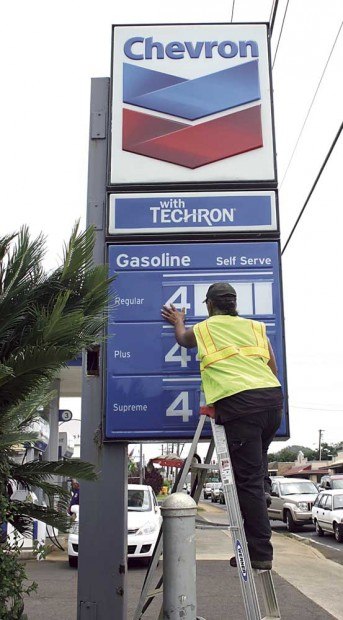LIHU‘E — Garden Isle gasoline prices continued to climb late last summer, up to $4.53 per gallon in Lihu‘e, despite the stock market’s plummet that drove crude prices down near $80 per barrel, an estimated 25 percent decline over April
LIHU‘E — Garden Isle gasoline prices continued to climb late last summer, up to $4.53 per gallon in Lihu‘e, despite the stock market’s plummet that drove crude prices down near $80 per barrel, an estimated 25 percent decline over April levels.
Lihu‘e fuel prices stagnated at $4.35 much of the summer, then climbed to $4.53 in September. In October, local fuel prices dropped 6 cents to $4.47, where it remains today, while crude has climbed back up to $94.42 a barrel and economists predict increases will continue in coming months.
But why don’t Kaua‘i’s fuel prices follow national trends? It appears to be a matter of demand, supply and competition.
State energy reports say Hawai‘i’s oil supply doesn’t come from the same primary sources as the Mainland, such as Middle Eastern countries. Rather, 40 percent comes from Alaska and 60 percent comes from South Asia, where prices have remained high throughout the summer. Asia-Pacific tapis crude oil spot price on Saturday was $123.34 per barrel.
The State of Hawai‘i Energy Resources Coordinator’s 2010 Annual Report states that Hawai‘i is the most oil-dependent state in the nation with 91 percent of its energy consumption coming from imported fossil fuels, thereby creating high demand.
Furthermore, there are only two oil refiners in the state — Chevron and Tosoro, both located on O‘ahu — which creates a lack of pricing competition.
Sustained, elevated fuel prices can suck the life out of small communities. The level of damage is often hard to quantify, but Bob Hinkling came up with some firm numbers.
Hinkling is a Kaua‘i gasoline watchdog who tracks local fuel prices to gauge with the rest of the country. “The gouge is on,” he said. He sent a copy of his most recent chart to The Garden Island that shows an ever-widening gap between worldwide crude and local fuel.
“I decided to extend the gouge interval back to the time when gas went above 20 cents too high,” Hinkling wrote in an email. “That makes it 13 weeks, which is exactly one quarter. The total excess money extracted from Kaua‘i in that time is just short of $5 million.”
His figures look like this: Kaua‘i consumption 600,000 gallons per week, average gouge 63 cents per gallon, average $378,000 per week, gouge duration 13 weeks, total gouge $4,914,000.
If his figures are right, Kaua‘i businesses could be feeling a hit during the holidays.
Basic microeconomic theory contends that there are ties between consumer confidence and fuel prices.
When prices are high or unstable, shoppers reign in the purse strings on discretionary spending and business hesitate to hire, which can turn into a self-perpetuating negative cycle.
• Vanessa Van Voorhis, staff writer, can be reached at 245-3681 (ext. 251) or by emailing vvanvoorhis@thegardenisland.com.


